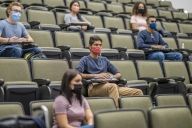You have /5 articles left.
Sign up for a free account or log in.
Access to all aspects of the college experience is a critical component of the work we do in higher education. Since the passing of the Americans with Disabilities Act 26 years ago, all campuses have seen an increase in accommodations—mobility ramps, adjusted restrooms, braille signage, and more—leading to a more diverse campus population. But recent, successful law suits brought by students against several universities across the country should remind us there is much more to be done, and it begins with being open to thinking about access in all its many forms.
The National Technical Institute for the Deaf, one of the nine colleges of Rochester Institute of Technology, was established nearly 50 years ago as the first and largest technological college in the world for deaf and hard-of-hearing students. It was designed with accessibility in mind and can serve as a model for other campuses to follow.
While focusing on accessibility makes sense for NTID because of its unique population, ensuring access has benefited all members of the campus community, not just those for whom the access was originally intended. In much the same way as sidewalk curbs being lowered benefit not only those in wheelchairs, but also those on bicycles and pushing strollers, captioning of all video media produced on our campus benefits not only our deaf students, but hearing students who may wish to turn off the sound to not disturb others, or who may be in a loud area where it is difficult to distinguish sound.
When we think about diversity, we tend to think demographically: gender, ethnicity, and the like. And when we think about disability, we tend to think about mobility, developmental and perhaps visual issues. But deafness is not always top of mind. And deafness is unique among so-called disabilities because for many, deafness also carries a cultural component.
According to the National Center for Health Statistics, approximately 15 percent of American adults (37.5 million) aged 18 and over report some trouble hearing. And approximately 12.6 percent of all Americans reported some form of disability. Of RIT’s more than 15,000 students, 1,200, nearly 10 percent, are deaf or hard of hearing, with half taking classes in the College of NTID and the rest enrolled throughout RIT’s other colleges. NTID also has nearly 100 deaf and hard-of-hearing faculty and staff, and our president, who is deaf, is the first alumnus to hold this office.
This means awareness of deafness, communication preference and cultural characteristics is important not only in one college or location on campus, but throughout the university. And while we focus on deafness, we also must use the same principles to accommodate a variety of secondary disabilities such as visual impairments, mobility issues, learning and developmental challenges, and more.
When NTID was established by an act of Congress and signed into law by President Lyndon Baines Johnson 50 years ago, the college’s founders called it “the grand experiment.” They wondered if it was possible to educate and integrate deaf and hard-of-hearing students on a campus where hearing students were the majority.
And what we’ve learned is that it can be done, but there are several keys to success. These keys can benefit everyone at your institution as your population becomes more diverse:
- Be open minded. When building a new research center on campus, we sought input from deaf students and had an architect and former alumnus serve as a consultant.
- Be respectful. Remember that not all learning happens in the classroom, and that incidental learning—that ‘water cooler’ style chatter—contains information that benefits all.
- Advocate for yourself and others. Presenting compelling rationale for changes to enhance accessibility to administrators is everyone’s job.
- Remember that clarity is the goal. Clear communication both in and out of the classroom in all its forms should be at the forefront of all accessibility efforts.
- Be flexible and try new things. If they don’t work, try other new things. Advances in technology have helped to ‘level the playing field’ for students—at RIT/NTID, we have a Center on Access Technology devoted to adapting the latest mobile applications to benefit students in the classroom. One such example is the use of a ‘flipped classroom’ where lectures are videotaped and captioned for students to watch prior to class, and class time is spent working on what once were homework assignments.
- Patience is what it’s all about. We know change takes time. And it’s worth the time that needs to be put into it.
- Be supportive. You don’t need to have a personal experience to be supportive of the changes that are necessary to create an accessible campus. This support can be as simple as taking a language class (in the case of RIT/NTID, sign language), reading up on the best ways to work with students with different needs, or—perhaps even more powerful—ask the person needing accommodations how you can be part of the solution.
- Be persistent. Seems simple, but often times changing a culture can take more effort than a lot of administrations are prepared to handle. Focus on the benefits and don’t stop moving forward.
Today’s campuses are—and should be—increasingly diverse and inclusive. The more we embrace all the ways our students, faculty and staff are different, the more we experience the variety of life experiences and cultural diversity that enriches us all.
Susan Murad is the director of Public Relations and Technology Transfer at Rochester Institute of Technology’s National Technical Institute for the Deaf. She has more than 25 years of communication and marketing experience in higher education, non-profit and corporate industries.








